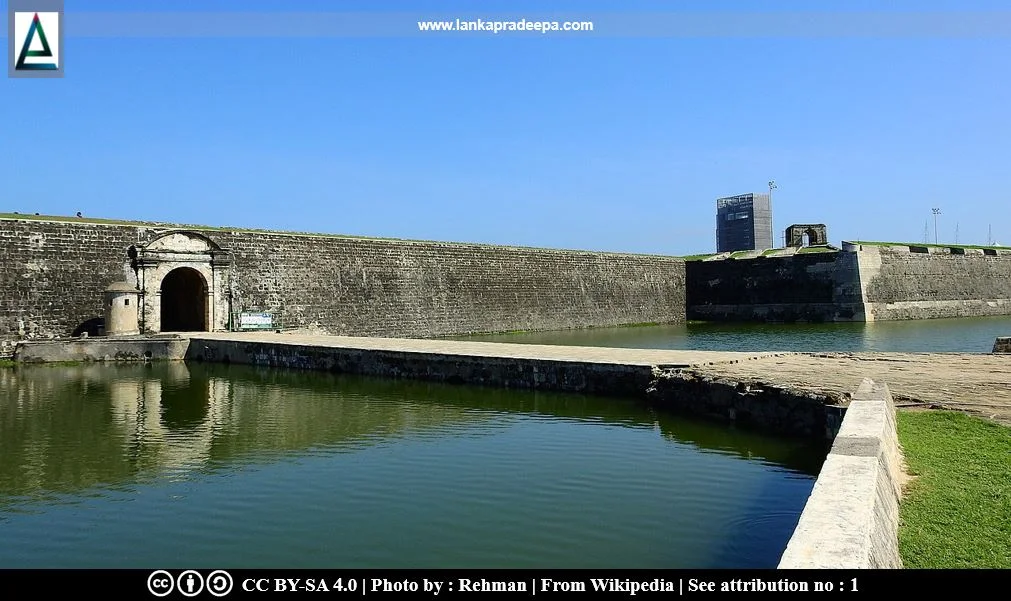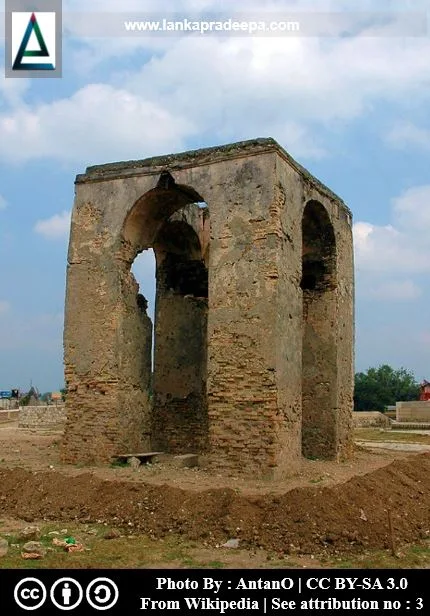
Jaffna Fort (Sinhala: යාපනය බලකොටුව; Tamil: யாழ்ப்பாணக் கோட்டை) is a colonial fort built in Jaffna District, Sri Lanka. Situated closer to the south of the Jaffna Peninsula, the fort has been erected adjacent to the Jaffna Lagoon (Wijebandara, 2014). The fort is considered an outstanding Dutch architectural site found in the South East Asian region.
History
Jaffna was controlled by the Portuguese from 1619 to 1658 and then by Dutch from 1658 to 1796 and finally by the British from 1796 to 1948 (Wijebandara, 2014). The fort was built by the Portuguese in 1619, as a four-sided garrison with other components such as ramparts, corner bastions, and a moat (Dias et al., 2016; Wijebandara, 2014). In 1658, it was captured by the Dutch after a three-month and a-half-month siege (Mandawala, 2012). The Dutch expanded and converted it into a pentagon-shaped fort using building materials such as limestones, coral stones, etc. to facilitate trading activities in Sri Lanka's Northern region. The fort also included inner fortifications with ramparts, corner bastions, and a star-shaped moat. In September 1796, the British took over control of it (Wijebandara, 2014). They made a few renovations to the fort and used it as their administrative garrison.
Summary (Wijebandara, 2014)
1617 - Portuguese captured Jaffna and Phillippe de Oliveira became the first Governor.
1624 - Commencing the construction works of the Jaffna Fort.
1624 - (22 March) Death of the Phillippe de Oliveira.
1632 - Ending the construction works of the Jaffna Fort.
1658 - (March) Dutch captured the fort.
1665 - Designing the Jaffna Fort.
1680 - Finishing the construction works of the inner defence zone.
1792 - Ending the construction works of the Jaffna Dutch fort.
1795 - (28 September) British captured Jaffna.
1796 - (September) British established their control over the Jaffna Peninsula.
Excavations in 2011
An excavation pit dug inside the Jaffna Fort in 2011 revealed that the history of this premises goes back to the middle-Anuradhapura Period or 6-7th centuries A.D. (Wijebandara, 2014). A large number of clay pottery pieces, some of Rome (such as Amphora jar) and of Chinese origin, were found during the excavation. Pottery pieces related to the Chola Period (10th century) and to the 10-13th centuries A.D. were also found (Wijebandara, 2014).
Chola inscription of Jaffna fort
A slab containing a Tamil inscription dated in the reign of a South-Indian Chola king was discovered on the fort premises (Wijebandara, 2014).
Fort
In terms of size, Jaffna Fort is only second to the Galle Fort which is the largest fort in the country (Dias et al., 2016; Wijebandara, 2014). It expands to an area of about 64 acres (Dias et al., 2016; Wijebandara, 2014). It has a 40 ft. wide base and a slope of 20 ft. wide parapet walls. Outside the parapet is a deep moat. It originally had five ramparts, an artillery fortification, a protestant church, a prison, Queen's place, administrative garrisons, and 21 dug wells. Also, there were three bridges between the outer fortifications and the inner fort across the moat.
Unlike the forts at Colombo and Galle which were fortified towns, the Jaffna Fort was used exclusively for military and administrative purposes (Mandawala, 2012). It is the only fort in Sri Lanka where its inner defences have a geometrically regular pentagonal layout (Dias et al., 2016). Also, it is the only example in the country where outer fortifications consisting of glacis, ravelins, and covered ways are found (Dias et al., 2016). The present Duraiappa stadium and Muneeswaran Kovil are said to have been built in the area where the glacis of the old fort are located (Wijebandara, 2014).
Although it was first built by the Portuguese, it is presently known as a Dutch fort because of its typical Dutch architectural features. Until the 1970s, the fort and its building were in their original state, and to protect them, the site was declared an archaeological reserve on 31 May 1971 by the government (Dias et al., 2016; Mandawala, 2012; Wijebandara, 2014). However, some parts of the fort were damaged during the Sri Lankan civil war (Dias et al., 2016; Mandawala, 2012). After the end of the civil war in 2009, the conservation of the fort was commenced by the Department of Archaeology with the assistance of the Government of the Netherlands (Dias et al., 2016; Wijebandara, 2014).


 .
.
2) Jaffna Fort (2) by Rehman is licensed under CC BY-SA 4.0
3) Jaffna Fort - Hangman's Tower by AntanO is licensed under CC BY-SA 3.0
4) Джафна by Inna67895 is licensed under CC BY-SA 4.0


 .
.
Attribution
1) Jaffna Fort (1) by Rehman is licensed under CC BY-SA 4.02) Jaffna Fort (2) by Rehman is licensed under CC BY-SA 4.0
3) Jaffna Fort - Hangman's Tower by AntanO is licensed under CC BY-SA 3.0
4) Джафна by Inna67895 is licensed under CC BY-SA 4.0
References
1) Dias, M.;
Koralage, S.B.; Asanga, K., 2016. The archaeological heritage of Jaffna
peninsula. Department of Archaeology. Colombo. pp.195-197.
2) Mandawala, P.B., 2012. Sri Lanka: Defending the military heritage; legal, administrative and financial challenges. Defending the military heritage; legal, financial and administrative issues. Reports from the Seminar 16 – 17 May, 2011, in Karlskrona, Sweden, organised by ICOMOS International Scientific Committee for Legal, Financial and Administrative Issues (ICLAFI) and the Swedish Fortifications Agency of Sweden. p.100.
3) Wijebandara, I.D.M., 2014. Yapanaye Aithihasika Urumaya (In Sinhala). Published by the editor. ISBN-978-955-9159-95-7. pp.38-50.
2) Mandawala, P.B., 2012. Sri Lanka: Defending the military heritage; legal, administrative and financial challenges. Defending the military heritage; legal, financial and administrative issues. Reports from the Seminar 16 – 17 May, 2011, in Karlskrona, Sweden, organised by ICOMOS International Scientific Committee for Legal, Financial and Administrative Issues (ICLAFI) and the Swedish Fortifications Agency of Sweden. p.100.
3) Wijebandara, I.D.M., 2014. Yapanaye Aithihasika Urumaya (In Sinhala). Published by the editor. ISBN-978-955-9159-95-7. pp.38-50.
Location Map
This page was last updated on 14 January 2023

